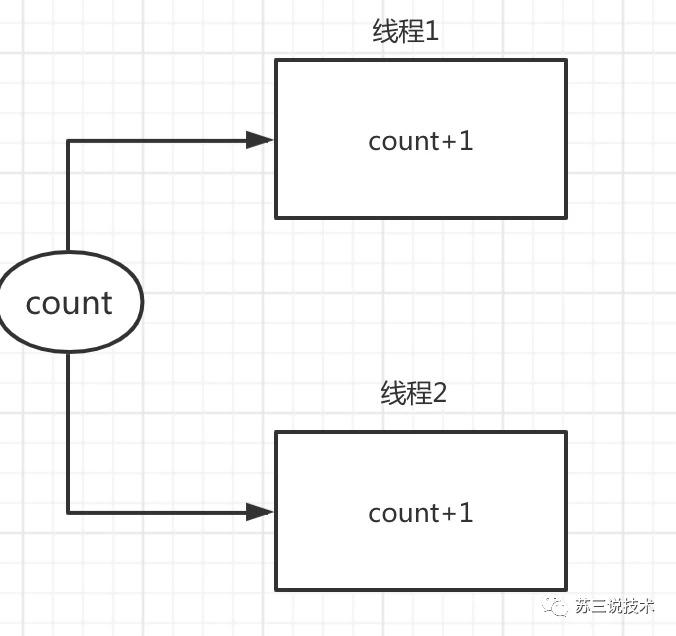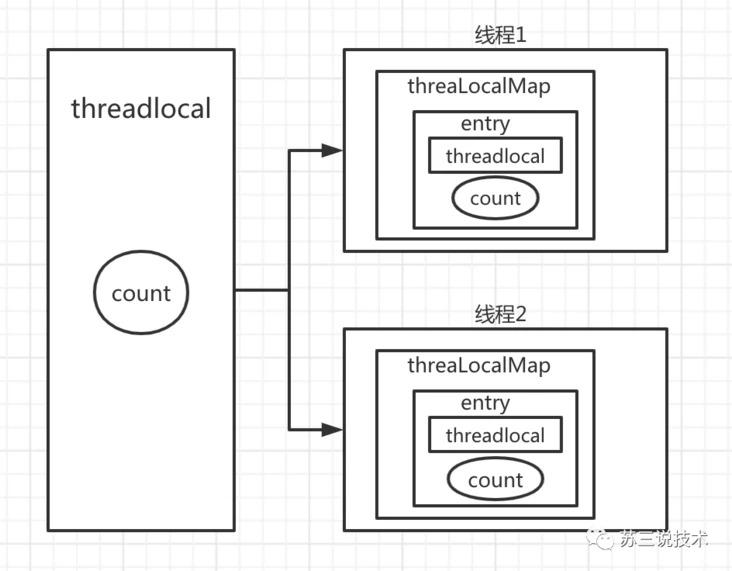深入剖析ThreadLocal
深入剖析ThreadLocal
前言
朋友们在遇到线程安全问题的时候,大多数情况下可能会使用synchronized关键字,每次只允许一个线程进入锁定的方法或代码块,这样就可以保证操作的原子性,保证对公共资源的修改不会出现莫名其妙的问题。这种加锁的机制,在并发量小的情况下还好,如果并发量较大时,会有大量的线程等待同一个对象锁,会造成系统吞吐量直线下降。
JDK的开发者可能也考虑到使用synchronized的弊端,于是出现了volatile 和 ThreadLocal等另外的思路解决线程安全问题。volatile它所修饰的变量不保留拷贝,直接访问主内存,主要用于一写多读的场景。ThreadLocal是给每一个线程都创建变量的副本,保证每个线程访问都是自己的副本,相互隔离,就不会出现线程安全问题,这种方式其实用空间换时间的做法。其他的内容以后有空再讨论,今天我们重点聊一下 ThreadLocal。
接下来,我们将从以下几个方面介绍ThreadLocal
如何使用ThreadLocal? - ThreadLocal的工作原理 - ThreadLocal源码解析 - ThreadLocal有哪些坑
1.如何使用ThreadLocal?
在使用ThreadLocal之前我们先一起看个例子
/**
* 不安全线程场景
*
* @author sue
* @date 2020/8/12 21:21
*/
public class TestThread {
private int count = 0;
public void calc() {
count++;
}
public int getCount() {
return count;
}
public static void main(String[] args) throws InterruptedException {
TestThread testThread = new TestThread();
for (int i = 0; i < 20; i++) {
new ThreadA(i, testThread).start();
}
Thread.sleep(200);
System.out.println("realCount:" + testThread.getCount());
}
}
class ThreadA extends Thread {
private int i;
private TestThread testThread;
ThreadA(int i, TestThread testThread) {
this.i = i;
this.testThread = testThread;
}
public void run() {
try {
Thread.sleep(10);
} catch (InterruptedException e) {
e.printStackTrace();
}
testThread.calc();
System.out.println("i:" + i + ",count:" + testThread.getCount());
}
}
运行结果:
i:8,count:8
i:7,count:8
i:11,count:10
i:4,count:11
i:13,count:12
i:2,count:8
i:0,count:8
i:9,count:8
i:3,count:8
i:1,count:8
i:5,count:8
i:6,count:8
i:12,count:11
i:10,count:9
i:14,count:15
i:18,count:17
i:15,count:18
i:17,count:16
i:16,count:15
i:19,count:18
realCount:18
我们可以看到,realCount最终出现错误,预计的结果应该是20,实际情况却是18,出现了线程安全问题。
接下来,把程序改成ThreadLocal运行结果会怎样?
/**
* ThreadLocal场景
*
* @author sue
* @date 2020/8/12 21:21
*/
public class TestThreadLocal {
private ThreadLocal<Integer> threadLocal = new ThreadLocal<>();
public void calc() {
threadLocal.set(getCount() + 1);
}
public int getCount() {
Integer integer = threadLocal.get();
return integer != null ? integer : 0;
}
public static void main(String[] args) throws InterruptedException {
TestThreadLocal testThreadLocal = new TestThreadLocal();
for (int i = 0; i < 20; i++) {
new ThreadB(i, testThreadLocal).start();
}
Thread.sleep(200);
System.out.println("realCount:" + testThreadLocal.getCount());
}
}
class ThreadB extends Thread {
private int i;
private TestThreadLocal testThreadLocal;
ThreadB(int i, TestThreadLocal testThreadLocal) {
this.i = i;
this.testThreadLocal = testThreadLocal;
}
public void run() {
try {
Thread.sleep(10);
} catch (InterruptedException e) {
e.printStackTrace();
}
testThreadLocal.calc();
System.out.println("i:" + i + ",count:" + testThreadLocal.getCount());
}
}
运行结果:
i:6,count:1
i:10,count:1
i:3,count:1
i:0,count:1
i:7,count:1
i:11,count:1
i:9,count:1
i:5,count:1
i:8,count:1
i:1,count:1
i:4,count:1
i:2,count:1
i:13,count:1
i:15,count:1
i:14,count:1
i:19,count:1
i:18,count:1
i:17,count:1
i:12,count:1
i:16,count:1
realCount:0
我们可以看到,跟之前的例子运行结果差别很大,首先现在count全部都是1,之前count有8,10,11,12等很多值。其次realCount之前是18,现在的realCount却是0。为什么会造成这样的差异呢?
2.ThreadLocal的工作原理
先看看示例1中的情况

我们可以看到多个线程可以同时访问公共资源count,当某个线程在执行count++的时候,可能其他的线程正好同时也执行count++。但由于多个线程变量count的不可见性,会导致另外的线程拿到旧的count值+1,这样就出现了realCount预计是20,但是实际上是18的数据问题。
再看看示例2中的情况:

如图所示,往大的方向上说,ThreadLocal会给每一个线程都创建变量的副本,保证每个线程访问都是自己的副本,相互隔离。
往小的方向上说,每个线程内部都有一个threadLocalMap,每个threadLocalMap里面都包含了一个entry数组,而entry是由threadLocal和数据(这里指的是count)组成的。这样一来,每个线程都拥有自己专属的变量count。
示例2中线程1调用calc方法时,会先调用的getCount方法,由于第一次调用threadLocal.get()返回是空的,所以getCount返回值是0。这样threadLocal.set(getCount() + 1);就变成了threadLocal.set(0 + 1);它会给线程1中threadLocal的数据值设置成1。线程2再调用calc方法,同样会先调用getCount方法,由于第一次调用threadLocal.get()返回是空的,所以getCount返回值也是0。
这样threadLocal.set(getCount() + 1);会给线程2中threadLocal的数据值也设置成1。。。。。。最后每个线程的threadLocal中的数据值都是1。
还有,示例2中打印出来的realCount为什么是0呢?
因为testThreadLocal.getCount()是在主线程中调用的,其他的线程改变只会影响自己的副本,不会影响原始变量,count初始值是0,所以最后还是0。
3.ThreadLocal源码解析
在介绍ThreadLocal之前,让我们一起先看看Thread类
ThreadLocal.ThreadLocalMap threadLocals = null;
可以看到Thread类中定义了一个叫threadLocals的成员变量,它的类型是ThreadLocal.ThreadLocalMap。很明显ThreadLocalMap是ThreadLocal的内部类,验证了我在图中画的内容,每个线程都有一个ThreadLocalMap对象。
我们再重点看看ThreadLocalMap
static class ThreadLocalMap {
static class Entry extends WeakReference<ThreadLocal<?>> {
/** The value associated with this ThreadLocal. */
Object value;
Entry(ThreadLocal<?> k, Object v) {
super(k);
value = v;
}
}
/**
* The initial capacity -- MUST be a power of two.
*/
private static final int INITIAL_CAPACITY = 16;
/**
* The table, resized as necessary.
* table.length MUST always be a power of two.
*/
private Entry[] table;
/**
* The number of entries in the table.
*/
private int size = 0;
/**
* The next size value at which to resize.
*/
private int threshold; // Default to 0
/**
* Set the resize threshold to maintain at worst a 2/3 load factor.
*/
private void setThreshold(int len) {
threshold = len * 2 / 3;
}
........省略
}
由于该方法太长了,我在这里省略了部分内容。从以上代码可以看到ThreadLocalMap里面包含了一个叫table的数组,它的类型是Entry,Entry是WeakReference(弱引用)的子类,Entry又包含了 ThreadLocal变量 和Object的value ,其中ThreadLocal变量做为WeakReference的referent。
接下来,我们再回到ThreadLocal类,常用的其实就下面四个方法:get(), initialValue(),set(T value) 和 remove(),接下来我们会逐一介绍。
首先看看get()方法
public T get() {
//获取当前线程
Thread t = Thread.currentThread();
//获取当前线程中的ThreadLocalMap对象
ThreadLocalMap map = getMap(t);
//如果可以查询到数据
if (map != null) {
//从ThreadLocalMap中获取entry对象
ThreadLocalMap.Entry e = map.getEntry(this);
//如果entry存在
if (e != null) {
@SuppressWarnings("unchecked")
//获取entry中的值
T result = (T)e.value;
//返回获取到的值
return result;
}
}
//调用初始化方法
return setInitialValue();
}
其中的getMap方法
ThreadLocalMap getMap(Thread t) {
return t.threadLocals;
}
再简单不过了,直接返回的是当前线程的成员变量threadLocals
再看看getEntry方法
private Entry getEntry(ThreadLocal<?> key) {
//threadLocalHashCode是key的hash值
//key.threadLocalHashCode & (table.length - 1),
//相当于threadLocalHashCode对table.length - 1的取余操作,
//这样可以保证数组的下表在0到table.length - 1之间。
int i = key.threadLocalHashCode & (table.length - 1);
//获取下标对应的entry
Entry e = table[i];
//如果entry不为空,并且从弱引用中获取到的值(threadLocal) 和 key相同
if (e != null && e.get() == key)
//返回获取到的entry
return e;
else
//如果没有获取到entry或者e.get()获取不到数据,则清理空数据
return getEntryAfterMiss(key, i, e);
}
我之前说过entry是WeakReference的子类,那么e.get()方法会调用:
public T get() {
return this.referent;
}
``
返回的是一个引用,这个引用就是构造器传入的threadLocal对象。
getEntryAfterMiss里面有说明逻辑呢?
```java
private Entry getEntryAfterMiss(ThreadLocal<?> key, int i, Entry e) {
Entry[] tab = table;
int len = tab.length;
while (e != null) {
ThreadLocal<?> k = e.get();
if (k == key)
return e;
if (k == null)
expungeStaleEntry(i);
else
i = nextIndex(i, len);
e = tab[i];
}
return null;
}
该方法里面会调用expungeStaleEntry方法,后面我们会重点介绍的。
再看看setInitialValue方法
protected T initialValue() {
return null;
}
private T setInitialValue() {
//调用用户自定义的initialValue方法,默认值是null
T value = initialValue();
//获取当前线程
Thread t = Thread.currentThread();
//获取当前线程中的ThreadLocalMap,跟之前一样
ThreadLocalMap map = getMap(t);
//如果ThreadLocalMap不为空,
if (map != null)
//则覆盖key为当前threadLocal的值
map.set(this, value);
else
//否则创建新的ThreadLocalMap
createMap(t, value);
//返回用户自定义的值
return value;
}
当中的initialValue()方法,就是我们要介绍的第二个方法
protected T initialValue() {
return null;
}
我们可以看到该方法只有一个空实现,等着用户的子类重写之后重新实现。
接下来重点看看threadLocalMap的set方法
private void set(ThreadLocal<?> key, Object value) {
//将table数组赋值给新数组tab
Entry[] tab = table;
//获取数组长度
int len = tab.length;
//跟之前一样计算数组中的下表
int i = key.threadLocalHashCode & (len-1);
//循环变量tab获取entry
for (Entry e = tab[i];
e != null;
e = tab[i = nextIndex(i, len)]) {
//获取entry中的threadLocal对象
ThreadLocal<?> k = e.get();
//如果threadLocal对象不为空,并且等于key
if (k == key) {
//覆盖已有数据
e.value = value;
//返回
return;
}
//如果threadLocal对象为空
if (k == null) {
//创建一个新的entry赋值给已有key
replaceStaleEntry(key, value, i);
return;
}
}
//如果key不在已有数据中,则创建一个新的entry
tab[i] = new Entry(key, value);
//长度+1
int sz = ++size;
if (!cleanSomeSlots(i, sz) && sz >= threshold)
rehash();
}
replaceStaleEntry方法也会调用expungeStaleEntry方法。
再看看setInitialValue方法中的createMap方法
void createMap(Thread t, T firstValue) {
t.threadLocals = new ThreadLocalMap(this, firstValue);
}
代码很简单,就是new了一个ThreadLocalMap对象。
好了,到这来get() 和 initialValue() 方法介绍完了。
下面介绍set(T value) 方法
public void set(T value) {
//获取当前线程,都是一样的套路
Thread t = Thread.currentThread();
//根据当前线程获取当中的ThreadLocalMap
ThreadLocalMap map = getMap(t);
//ThreadLocalMap不为空,则调用之前介绍过的ThreadLocalMap的set方法
if (map != null)
map.set(this, value);
else
//如果ThreadLocalMap为空,则创建一个对象,之前也介绍过
createMap(t, value);
}
so easy
最后,看看remove()方法
public void remove() {
//还是那个套路,不过简化了一下
//先获取当前线程,再获取线程中的ThreadLocalMap对象
ThreadLocalMap m = getMap(Thread.currentThread());
//如果ThreadLocalMap不为空
if (m != null)
//删除数据
m.remove(this);
}
这个方法的关键就在于ThreadLocalMap类的remove方法
private void remove(ThreadLocal<?> key) {
//将table数组赋值给新数组tab
Entry[] tab = table;
//获取数组长度
int len = tab.length;
//跟之前一样计算数组中的下表
int i = key.threadLocalHashCode & (len-1);
//循环变量从下表i之后不为空的entry
for (Entry e = tab[i];
e != null;
e = tab[i = nextIndex(i, len)]) {
//如果可以获取到threadLocal并且值等于key
if (e.get() == key) {
//清空引用
e.clear();
//处理threadLocal为空但是value不为空的entry
expungeStaleEntry(i);
return;
}
}
}
其中的clear方法,也很简单,只是把引用设置为null,即清空引用
public void clear() {
this.referent = null;
}
我们可以看到get()、set(T value) 和 remove()方法,都会调用expungeStaleEntry方法,我们接下来重点看一下expungeStaleEntry方法
private int expungeStaleEntry(int staleSlot) {
Entry[] tab = table;
int len = tab.length;
//将位置staleSlot对应的entry中的value设置为null,有助于垃圾回收
tab[staleSlot].value = null;
//将位置staleSlot对应的entry设置为null,有助于垃圾回收
tab[staleSlot] = null;
//数组大小-1
size--;
Entry e;
int i;
//变量staleSlot之后entry不为空的数据
for (i = nextIndex(staleSlot, len);
(e = tab[i]) != null;
i = nextIndex(i, len)) {
//获取当前位置的entry中对应的threadLocal
ThreadLocal<?> k = e.get();
//threadLocal为空,说明是脏数据
if (k == null) {
//value设置为null,有助于垃圾回收
e.value = null;
//当前位置的entry设置为null
tab[i] = null;
//数组大小-1
size--;
} else {
//重新计算位置
int h = k.threadLocalHashCode & (len - 1);
//如果h和i不相等,说明存在hash冲突
//现在它前面的脏Entry被清理
//该Entry需要向前移动,防止下次get()或set()的时候
//再次因散列冲突而查找到null值
if (h != i) {
tab[i] = null;
while (tab[h] != null)
h = nextIndex(h, len);
tab[h] = e;
}
}
}
return i;
}
该方法首先清除当前位置的脏Entry,然后向后遍历直到table[i]==null。在遍历的过程中如果再次遇到脏Entry就会清理。如果没有遇到就会重新变量当前遇到的Entry,如果重新散列得到的下标h与当前下标i不一致,说明该Entry被放入Entry数组的时候发生了散列冲突(其位置通过再散列被向后偏移了),现在其前面的脏Entry已经被清除,所以当前Entry应该向前移动,补上空位置。否则下次调用set()或get()方法查找该Entry的时候会查找到位于其之前的null值。
为什么要做这样的清除?
我们知道entry对象里面包含了threadLocal和value,threadLocal是WeakReference(弱引用)的referent。每次垃圾回收期触发GC的时候,都会回收WeakReference的referent,会将referent设置为null。那么table数组中就会存在很多threadLocal = null 但是 value不为空的entry,这种entry的存在是没有任何实际价值的。这种数据通过getEntry是获取不到值,因为它里面有if (e != null && e.get() == key)这句判断。
为什么要使用WeakReference(弱引用)?
如果使用强引用,ThreadLocal在用户进程不再被引用,但是只要线程不结束,在ThreadLocalMap中就还存在引用,无法被GC回收,会导致内存泄漏。如果用户线程耗时非常长,这个问题尤为明显。
另外在使用线程池技术的时候,由于线程不会被销毁,回收之后,下一次又会被重复利用,会导致ThreadLocal无法被释放,最终也会导致内存泄露问题。
4.ThreadLocal有哪些坑
内存泄露问题:
ThreadLocal即使使用了WeakReference(弱引用)也可能会存在内存泄露问题,因为 entry对象中只把key(即threadLocal对象)设置成了弱引用,但是value值没有。还是会存在下面的强依赖:
Thread -> ThreaLocalMap -> Entry -> value
要解决这个问题就需要调用get()、set(T value) 或 remove()方法。但是 get()和set(T value) 方法是基于垃圾回收器把key回收之后的基础之上触发的数据清理。如果出现垃圾回收器回收不及时的情况,也一样有问题。
所以,最保险的做法是在使用完threadLocal之后,手动调用一下remove方法,从源码可以看到,该方法会把entry中的key(即threadLocal对象)和value一起清空。
线程安全问题:
可能有些朋友认为使用了threadLocal就不会出现线程安全问题了,其实是不对的。假如我们定义了一个static的变量count,多线程的情况下,threadLocal中的value需要修改并设置count的值,它一样有问题。
因为static的变量是多个线程共享的,不会再单独保存副本。
5.总结
- 每个线程都有一个threadLocalMap对象,每个threadLocalMap里面都包含了一个entry数组,而entry是由key(即threadLocal)和value(数据)组成。
- entry的key是弱引用,可以被垃圾回收器回收。
- threadLocal最常用的这四个方法:get(), initialValue(),set(T value) 和 remove(),除了initialValue方法,其他的方法都会调用expungeStaleEntry方法做key==null的数据清理工作。
- threadLocal可能存在内存泄露和线程安全问题,使用完之后,要手动调用remove方法。
你可能感兴趣的文章
热门推荐
-
2、 - 优质文章
-
3、 gate.io
-
8、 golang
-
9、 openharmony
-
10、 Vue中input框自动聚焦